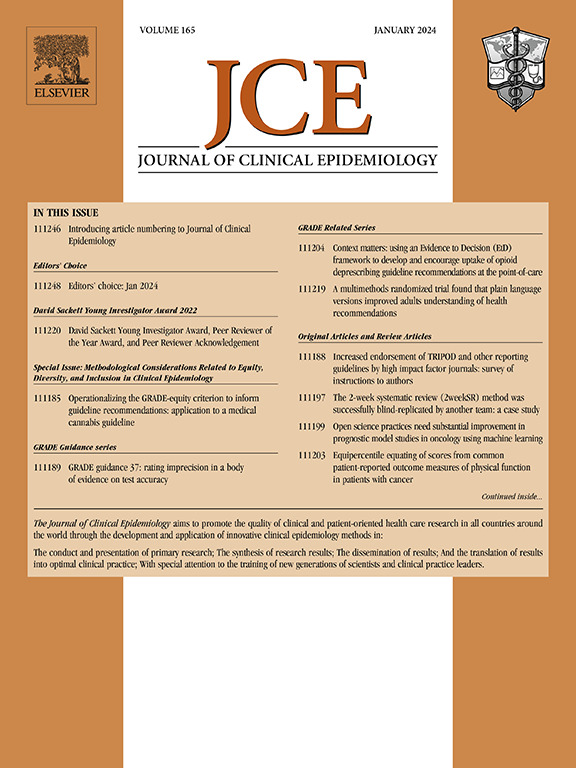Trial emulation to assess the effect of surgery on survival when there are competing risks, with application to patients with thoracic aortic aneurysms
IF 7.3
2区 医学
Q1 HEALTH CARE SCIENCES & SERVICES
引用次数: 0
Abstract
Objectives
This study extends methods to estimate average causal effect of aneurysm repair surgery on (i) overall survival and (ii) aneurysm-related mortality, accounting for competing risks using data from the Effective Treatment for Thoracic Aortic Aneurysm (ETTAA) cohort.
Study Design and Setting
ETTAA, a prospective cohort study, recruited 886 patients between 2014 and 2018. Patients were linked to UK national hospital and mortality databases by National Health Service digital and followed-up for later surgeries and deaths. We compared a strategy of open or endovascular surgery (whichever appropriate) within 12 months of enrollment to ETTAA with no surgery within 12 months using the trial emulation framework and cloning-censoring-weighting (CCW) analysis. Key confounders at baseline were controlled for using inverse probability weighting methods.
Results
In complete case analysis, if everyone received surgery within a 12-month grace period, an estimated 7-year survival probability was 57.4% (95% CI: 47.3%, 67.4%) vs 49.9% (44.0%, 55.0%) if no one received surgery. This benefit was primarily attributable to reduction in aneurysm-related deaths (difference −8.7%, 95% CI: −14.0%, −3.9%), with no significant effect on deaths from other causes. The findings were consistent under sensitivity analyses, including multiple imputation of missing confounders. Our CCW approach addressed selection-for-treatment, allowed for surgery to be received within a grace period, and used appropriate methods to separate aneurysm-related mortality from competing risks.
Conclusion
The study demonstrates the utility of trial emulation and counterfactual methods in estimation of causal effects on competing risks using observational data. The findings suggest a benefit for aneurysm-related survival up to 7 years after enrollment.
Plain Language Summary
This study shows how to estimate effects of surgery on different causes of death, when we cannot do a clinical trial, and illustrates this using an example from heart surgery. The aorta is the main artery that carries oxygen-rich blood from the heart to the body. In some people, a part of the vessel wall becomes weak and loses its elastic properties, so it doesn’t return to its normal shape after the blood has passed through. This can lead to swelling or bulging in the aorta, called an aneurysm. A thoracic aortic aneurysm, or TAA for short, is an aneurysm in the section of the aorta in the chest (https://www.bhf.org.uk/informationsupport/conditions/thoracic-aortic-aneurysm).
We have used data from the Effective Treatment for Thoracic Aortic Aneurysm (ETTAA) study, which investigated aneurysm growth rates, patient outcomes, quality of life, and costs, in 886 patients diagnosed with TAA. ETTAA compared two surgical treatments, Open Heart Surgery, where the section of the aorta that contains the aneurysm is removed and replaced by a new aorta made from a synthetic material, and Stent Grafting, where tubes are inserted into arteries to allow blood to flow freely using less invasive “keyhole” surgery. ETTAA reviewed existing research evidence but data comparing the effectiveness of these two approaches to each other and to outcomes without surgery were of sparse or limited quality and outdated. The results of ETTAA up to 2020 have been published in a monograph. (https://pubmed.ncbi.nlm.nih.gov/35094747/).
Two findings from ETTAA motivated this study. First, there were no clinical trials comparing surgery with no surgery and no studies that mimic clinical trials. Second, we had not considered whether surgery overall prevents deaths due to aneurysm or deaths from other causes. We call these two types of death, competing risks.
It is unlikely that a clinical trial comparing surgery with no surgery will ever be completed because the number of people who are diagnosed with TAA is small. Also, TAA can become a serious problem if left untreated. On the other hand, surgery for TAA is difficult and can result in serious complications, including death. Therefore, it is important to know how much surgery improves survival related to the aneurysm and whether it improves survival overall.
Recent developments in statistics provided methods for investigating survival in a way which increases confidence in the cause-effect relationship between surgery and outcomes. In this study, we show how these statistical methods can be used to estimate the proportion of patients who die from the competing risks, if all patients had surgery within 12 months compared with if no patients had surgery within 12 months. We take into account the different times between diagnosis of TAA and surgery and adjust for the main differences between surgery and no surgery patients. Using these methods, we estimate that surgery reduces deaths due to aneurysms at 7 years by 8.7%, with no effect on deaths from other causes. The benefit of surgery was significant by 3 years after diagnosis. We also provide discussion about using routine medical records to repeat this type of study.

试验模拟评估存在竞争风险时手术对生存的影响,并应用于胸主动脉瘤患者。
目的:本研究扩展了估计动脉瘤修复手术对(i)总生存率和(ii)动脉瘤相关死亡率的平均因果效应的方法,使用来自胸主动脉瘤有效治疗(etaa)队列的数据来考虑竞争风险。研究设计和环境:ETTAA是一项前瞻性队列研究,在2014年至2018年期间招募了886名患者。患者通过NHS数字数据库与英国国家医院和死亡率数据库联系起来,并对后来的手术和死亡进行随访。我们使用试验模拟框架和克隆-审查-加权分析,比较了在入组12个月内进行开放或血管内手术(任何合适的)的策略与在12个月内不进行手术的ETTAA。基线的关键混杂因素采用逆概率加权方法进行控制。结果:在完整的病例分析中,如果每个人在12个月的宽限期内接受手术,估计的7年生存率为57.4% (95% CI: 47.3%, 67.4%),而如果没有人接受手术,估计的7年生存率为49.9%(44.0%,55.0%)。这一益处主要归因于动脉瘤相关死亡的减少(差异-8.7%,95% CI: -14.0%, -3.9%),对其他原因导致的死亡没有显著影响。敏感性分析的结果是一致的,包括对缺失混杂因素的多重推测。我们的克隆-审查-加权方法解决了治疗选择问题,允许在宽限期内接受手术,并使用适当的方法将动脉瘤相关死亡率与竞争风险分开。结论:该研究证明了试验模拟和反事实方法在利用观测数据估计竞争风险因果效应方面的效用。研究结果表明,入组后动脉瘤相关生存率可达7年。
本文章由计算机程序翻译,如有差异,请以英文原文为准。
求助全文
约1分钟内获得全文
求助全文
来源期刊

Journal of Clinical Epidemiology
医学-公共卫生、环境卫生与职业卫生
CiteScore
12.00
自引率
6.90%
发文量
320
审稿时长
44 days
期刊介绍:
The Journal of Clinical Epidemiology strives to enhance the quality of clinical and patient-oriented healthcare research by advancing and applying innovative methods in conducting, presenting, synthesizing, disseminating, and translating research results into optimal clinical practice. Special emphasis is placed on training new generations of scientists and clinical practice leaders.
 求助内容:
求助内容: 应助结果提醒方式:
应助结果提醒方式:


